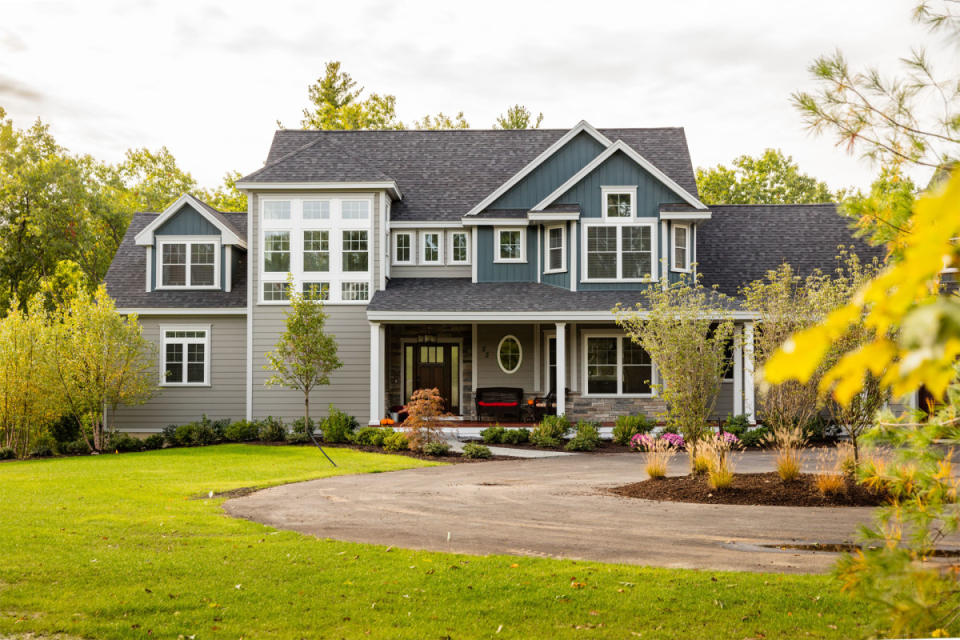5 Prevailing Trends in Home Siding
New exterior trends are pushing modern home design to unexpected places. See how new material technologies, eco-friendly processes, and design choices are steering exterior design choices among homeowners, and witness how major manufacturers are making way to meet the demand for residential design.
Prevailing Materials and Technology
"Fiber cement siding material – which is a practically indestructible combination of wood pulp, cement, sand, and other materials – is definitely becoming more popular due to its long-term durability, easy maintenance, long warranty, and energy efficiency," shares Andrew Prchal, President and Co-Founder, Gunner. "Aesthetically, there are a ton of different options too so the color and style can fit a homeowner’s vision and home’s architectural style."
Popular fiber cement brands include James Hardie, American Fiber Cement Corporation, GAF WeatherSide, Nichiha, Allura, Woodtone, and Finex.
He adds, "For homeowners seeking durable materials – whether it’s for longevity, or they live in a storm-prone area or face extreme weather conditions – we are really turning them on to fiber cement siding due to its minimal maintenance, incredible durability and lifespan and aesthetic flexibility with countless color and style options. This type of siding can last one a home for as many as 50 years, compared to more traditional vinyl siding which can last 20-40 years."

Westlake Royal Building Products
Celect Cellular Composite Siding, a premium PVC siding from Westlake Royal Building Products, also turns heads. "This durable building material replicates the beauty and aesthetics of wood while remaining low maintenance. Its patented interlocking seam design keeps moisture out and minimizes seams," shares Kriss Swint, director of marketing communications and design lead at Westlake Royal Building Products. "Plus, its Kynar Aquatec coating provides superior protection against UV rays, reduces energy demands, and resists dirt, staining, and insects. As climate change continues to intensify and lead to severe weather, there is a growing need for high-performance, weather-resistant building products."
Related: The Latest and Greatest in Residential Roofing Trends
Monochromatic Design is Increasing in Popularity
Consumers are gravitating toward modern designs, with one popular trend being a more monochromatic look. "[They are] utilizing the same color for their trim, gutters, and siding," shares Prchal. "We are also seeing homeowners slowly starting to move away from the classic white home and opt for darker colors like dark grays and greens.
Swint also notes a shift, "[We're seeing a lot of ] contrasting light and dark colors like matte black siding with brick, stone, shingles or wood siding to create architectural appeal."
Related: Trending Brick Colors for 2024: Stop and Peek at ‘Blue Smooth Ironspot’
Environmentally-Conscious Exterior Materials
Reducing one's carbon footprint is increasingly top-of-mind when executing a large renovation. Choosing sustainable, eco-friendly materials, and opting into recycling programs is becoming an increasingly popular choice for homeowners.
"We use PVC Trim and work with AZEK Company specifically to utilize their great recycling program," notes Prchal. "Instead of throwing away scraps trimmed from trim boards being thrown away (which is traditionally what happens in the siding industry!), we send them back to the AZEK Company and they reprocess the scraps, turning them into new materials to be used."
Swint echos demand for sustainable building materials and thoughtfulness around environmental impact, citting that "homeowners are leaning into a biophilic design which emphasizes a connection with nature, and enhances well-being and productivity. "Related trends include natural materials like green roofs, living walls, and large windows, as well as bold colors and earthy tones, such as navy blue, forest green, dark brown and red, combined with nature-inspired materials, offer organic texture and warmth."
Related: Starter Home = Forever Home? This New Trend is Driven By Interest Rates
Consumers Seek Energy Efficient Solutions
"We are definitely finding that homeowners are much more conscientious about energy efficiency these days," emphasizes Prchal. "We’ve started recommending a special water-resistive air barrier membrane that goes between the frame of the house, and the exterior siding. It is self-sealing around all nails and fasteners and eliminates traditional gaps that allow water, moisture and air in. It’s these gaps – even after brand new siding is installed – that decrease energy efficiency and can even reduce your air quality and cause mold in the long run."
Related: Residential Lighting Forecasts Emphasize Wellness and Connection to Nature—See the Trends
Continued Experimentation with Mixed Materials and Textures
The team at Westlake Royal Building Products predicts that in addition to sustainable materials, homeowners and designers will continue to play with a variety of brick, vinyl, stone, and wood textures to add depth and interest to homes.
Blending various textures, finishes, and materials creates visually dynamic exteriors.
Combining materials like brick and vinyl siding or stone and wood adds depth and interest.
Versetta Stone delivers the authentic look and feel of stone in a panelized format that is easy to install.
Cohesive materials and textures, such as stone veneer, can tie the outdoor space to the home's interior.
Look for a rise in classic design trends featuring elements such as vertical siding options, crisp white trim, and other modernized traditional siding styles.

